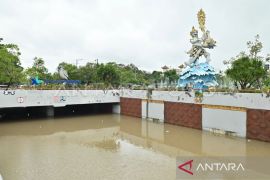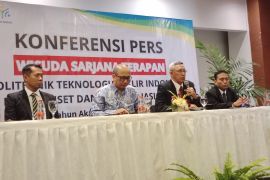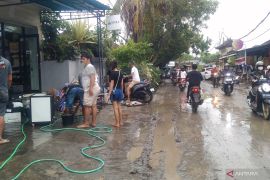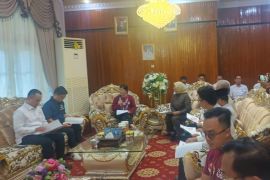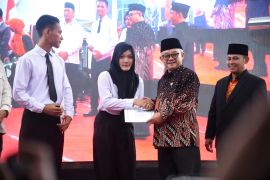Pertamina had applied a monitoring system capable of detecting the abuse of subsidized gas as early as possible.Jakarta (ANTARA News) - State-owned oil and gas company Pertamina has laid a gradual price increase roadmap for its liquefied petroleum gas (LPG) in an effort to reach economically viable gas price at about Rp11,944 per kilogram by mid-2016.
Based on the roadmap, Pertamina will gradually increase the price for consumers of LPG in 12-kilogram cylinders by Rp1 thousand per kilogram on July 1, 2014, and by Rp1,500 per kilogram during the first and second semesters of 2015 and 2016.
However, Pertamina had to put on hold its plan to raise LPG price on July 1, 2014, because it coincided with the fasting month of Ramadhan and Idul Fitri festivities during which the demand for LPG rises.
The oil company again postponed another plan to raise it on August 15, 2014, after it received a letter from the Coordinating Ministry for Economic Affairs Chairul Tanjung asking the company to put price rise on hold.
In a letter dated August 6, 2014, Pertamina proposed an increase of Rp1,500 per kilogram or Rp18 thousand per 12-kilogram cylinder beginning August 15, 2014.
The letter stated that the planned increase in LPG price should be discussed first with the government. "We follow the governments directives," Pertamina Marketing and Commercial Director Hanung Budya said last month (August 16, 2014).
After the meeting, the government had agreed to a proposal by Pertamina to increase the price of non-subsidized gas in 12-kilogram cylinders.
"We support Pertaminas proposal. We will leave it to Pertamina to decide the price rate and date of the increase," Minister Chairul Tanjung said on Monday.
"The economic viability of non-subsidized LPG in 12-kilogram cylinders is now far above the sale price. The price of gas in 12-kilogram cylinder is currently Rp6,100 per kilogram, while its economic viability price is Rp12,100 per kilogram, so that the difference between viability price and sale price is Rp6 thousand," Chairul said.
He pointed out that the large difference between viability price and sale price has burdened Pertamina. Therefore, the government has allowed Pertamina to raise its sale price.
Without an increase in price and subsidy from the government, Pertamina will suffer a loss of almost Rp6 trillion in 12-kilogram LPG business in 2014.
Pertamina Marketing and Commercial Director Hanung Budya said the rate and date of the increase will be decided by Pertamina in an internal meeting.
Finally, Pertamina announced on Wednesday that it had raised the price of LPG in 12-kilogram cylinder by Rp1,500 per kilogram or Rp18 thousand per 12-kilogram cylinder effective beginning at 00.00 hours local time on Wednesday, September 10, 2014.
Hanung Budya told at a press conference that Pertamina had raised the price of LPG in 12-kilogram cylinders in an effort to offset losses suffered by the company in the LPG business.
He noted that at the consumer level the price increase was between Rp21 thousand and Rp22 thousand per 12-kilogram cylinder because Pertamina had to bear additional transportation cost and retailers margin.
Before the price increase, the gas in 12-kilogram cylinder was sold to consumers at Rp100 thousand per cylinder. With the new price increase, gas in 12-kilogram cylinder will be sold at Rp120 thousand per cylinder.
Hanung said that the announcement of the price hike is a follow-up of an agreement reached between the government and Pertamina in a coordination meeting chaired by Chief Economic Minister Chairul Tanjung on Monday (September 8).
He stated that during the meeting the government had asked Pertamina to decide the rate and date of the increase in the price of gas in 12-kilogram cylinders. Pertamina earlier through its letter dated August 6, 2014, had asked for the governments approval for price rise.
It was earlier planned to be raised on August 15, but was then postponed. Based on the roadmap, as submitted by Pertamina to the Ministry of Energy and Mineral Resources on January 15, 2014, the price of non-subsidized gas in 12-kilogram cylinders will be raised gradually until it reaches its economic viability.
Regarding consumers who are financially weak, the government has provided subsidized gas in 3-kilogram cylinders.
According to the Regulation of the Energy and Mineral Resources Minister No. 26/2009, LPG in 3-kilogram cylinders should be only sold to households with a maximum monthly expenditure of Rp1.5 million and micro businesses with a monthly turnover of Rp50 million.
Yet, based on experience, consumers of LPG in 12-kilogram cylinders switched to LPG in 3-kilogram cylinders when there was a price increase in the 12-kilogram cylinder gas.
Director of PT Dwi Karya Mandala, Maya Novita, opined that the sale of gas in 3-kilogram cylinders is off target because the subsidized gas is also consumed by people of upper economic classes and businesses.
"The distribution to consumers of the subsidized gas in 3-kilogram cylinders is off target because it has been managed unprofessionally, in addition to the lack of supervision by Pertamina on distributors," she said on Wednesday.
She noted that the gas in 3-kilogram cylinders is sold without supervision, and any person can buy and use subsidized gas. "Shops at elite housing complexes and middle- and upper-class restaurants have been consuming subsidized gas, while actually they should consume gas in 12- and 50-kilogram cylinders," she said.
Therefore, with the price rise of gas in 12-kilogram cylinders, Pertamina has taken anticipatory steps to face the possibility of consumers switching to subsidized gas in 3-kilogram cylinders.
Pertamina had applied a monitoring system capable of detecting the abuse of subsidized gas as early as possible, including the possibility of consumers switching to non-subsidized gas due to disparities between the prices of LPG in 3-kilogram cylinders and 12-kilogram cylinders, Pertamina deputy president for LPG and gas products Gigih Wahyu Hari Irianto said.
Through the system called simol3k, Pertamina was able to monitor the movement of LPG in 3-kilogram cylinders at 3,400 agencies and 143 thousand depots across Indonesia, he noted.
"The system can monitor the distribution of LPG in 3-kilogram cylinders up to the village level. If consumption increases significantly, we can anticipate it earlier than usual," he stated.
The consumption of non-subsidized LPG in 12-kilogram cylinders currently stands at one million tons per year, while according to the quota in the revised 2014 state budget, the consumption of LPG in 3-kilogram cylinders has been set at 5.013 million tons per year.(*)
Reporter: Andi Abdussalam
Editor: Heru Purwanto
Copyright © ANTARA 2014



